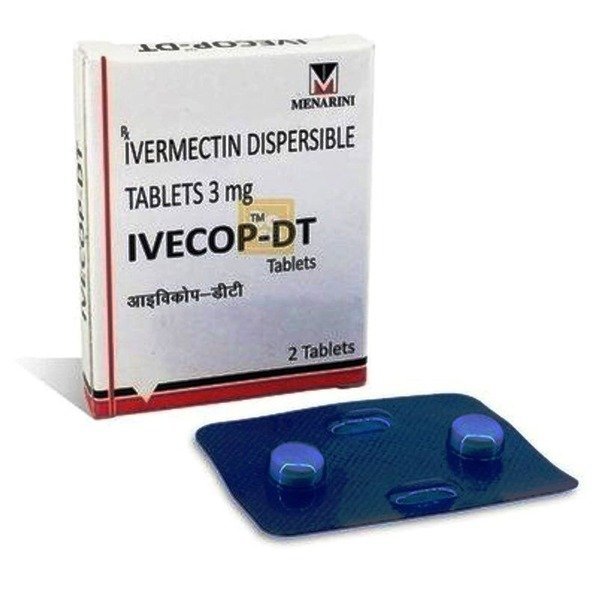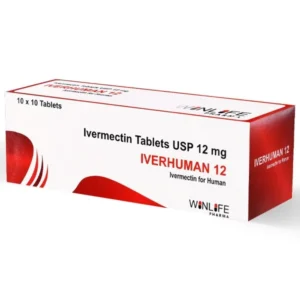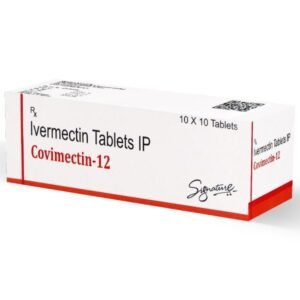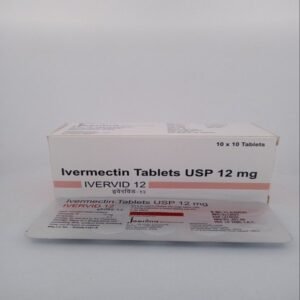Ivecop DT 3 mg is an antiparasitic agent containing Ivermectin, which is a medication used to treat several parasitic infections. It is an effective medicine in cases of onchocerciasis (river blindness), strongyloidiasis (threadworm infection), and it is also indicated for certain types of filariasis. This medication works by binding to nerve and muscle cells of parasites, thereby causing their paralysis and death.
Key Features
| About Ivecop DT 3 mg |
|---|
| Drug Class: Antiparasitic Agents |
| Subclass: Avermectin derivative |
| Product Details | |
|---|---|
| Composition | Active ingredient: Ivermectin Inactive ingredients: • Microcrystalline cellulose • Magnesium stearate • Silicon dioxide • Croscarmellose sodium • Corn starch • Pregelatinized starch |
| Packaging Type | Strip |
| Pack Size | 1×2 |
| Dosage | 3 mg |
| Therapeutic Class | Anthelmintic agents |
| Action Class | Antiparasitic |
| Chemical Class | Avermectin derivatives |
| Manufacturer | Menarini India Pvt Ltd |
| Shelf Life | 2–3 years from the date of manufacturing |
| Usages | Treats parasitic infections such as strongyloidiasis, onchocerciasis, scabies, and certain worm infestations. |
| Country of Origin | India |
| Storage | Store below 30°C, away from moisture and direct sunlight. |
How does Ivecop DT 3 mg work?
- Ivermectin binds selectively and with high affinity to glutamate-gated chloride ion channels present in invertebrate nerve and muscle cells.
- This binding leads to an increase in permeability of the cell membrane to chloride ions, resulting in hyperpolarization of the cell and eventually paralysis and death of the parasite.
Usage
- Management of onchocerciasis (river blindness).
- Treatment of strongyloidiasis (intestinal threadworm infection).
- Treatment of certain types of filariasis.
- Scabies and lice infestations (topical formulation).
Dosage
- Onchocerciasis: 150-200 mcg/kg as a single oral dose, repeated every 6-12 months as needed.
- Strongyloidiasis: The recommended dosage is 200 mcg/kg as a single oral dose.
- Scabies: 200 mcg/kg as a single oral dose. May repeat after 1 to 2 weeks.
- Take on an empty stomach with water.
Side effects
- Nausea and vomiting
- Diarrhea
- Dizziness
- Headache
- Muscle or joint pain
- Severe skin reactions
- Abnormalities of liver enzymes
- Low blood pressure
- Allergic reactions
Interaction
- CYP3A4 inhibitors: This drug may be increased by ketoconazole.
- Warfarin: may enhance anticoagulant effect.
- P-glycoprotein (P-gp): Ivermectin is a P-gp substrate, co-administration with P-gp inhibitors could alter central nervous system exposure.
- Avoid alcohol.
Pharmacokinetics
- Absorption: Well absorbed following oral administration.
- Distribution: Widely distributed in body tissues.
- Metabolism: Hepatic metabolism via CYP3A4.
- Excretion: Feces, minimal renal excretion.
- Half-life: approx. 18 hours.
Precautions
- Always use Ivecop DT 3 mg under medical supervision.
- Inform your doctor of liver disease, neurological conditions, pregnancy, or if you take medicines that affect CYP3A4 or P-gp.
- Pregnancy: Category C. Use if benefit outweighs risk.
- Breastfeeding: Excreted in breast milk; avoid use.
- Children: Safe in children >5 kg, Use with caution in liver disease.
Safety
Ivecop DT 3 mg (ivermectin) is generally well tolerated at standard doses. Safety points to remember:
- Caution in young children below the weight thresholds used in local guidelines. Some uses in very small children are off-label.
- Pregnant or breastfeeding patients should consult clinicians; local prescribing information will guide risk/benefit.
- In areas where Loa loa infection is common, screening and specialist guidance are important because of the risk of severe reactions with heavy microfilaria loads.
Efficacy
Ivermectin is highly effective for its approved parasitic indications. For many worm infections, a single dose dramatically reduces parasite counts and symptoms. In large public health programs, mass treatment with ivermectin has reduced disease burden from onchocerciasis in endemic regions. Treatment success depends on correct dosing and follow-up.
Conclusion
Ivecop DT 3 mg is highly effective and one of the most commonly used antiparasitic drugs. The drug is indicated for infections such as onchocerciasis, strongyloidiasis, and certain filariasis. It is usually safe and well-tolerated when administered in a manner appropriate for its use. However, it has numerous side effects and drug interactions; hence, it is recommended to be taken under the guidance of a doctor. Consult your doctor before taking it. Also, take the dosage that your physician prescribes.
FAQs
1. What for Ivecop DT 3 mg used for?
Ivecop DT 3 mg is used to treat several parasitic infections like Onchocerciasis and Strongyloidiasis.
2.How does Ivecop DT 3 mg work?
Ivecop DT 3 mg binds selectively and with high affinity to glutamate-gated chloride ion channels present in invertebrate nerve and muscle cells, leads to paralysis and death of parasite.
3.Is Ivecop DT 3 mg safe for everyone?
Yes, Ivecop DT 3 mg is safe, but it is recommended to use only after consulting a medical professional.
4.What can be the possible side effects after taking Ivecop DT 3 mg?
The possible side effects can be Nausea, vomiting, diarrhea, dizziness and headache.
References
| Ivecop DT | 30 Tablets $55, 50 Tablets $80, 100 Tablets $140, 300 Tablets $290 |
|---|
1 review for Ivecop DT
You must be logged in to post a review.








Wei Zhang –
Very satisfied.